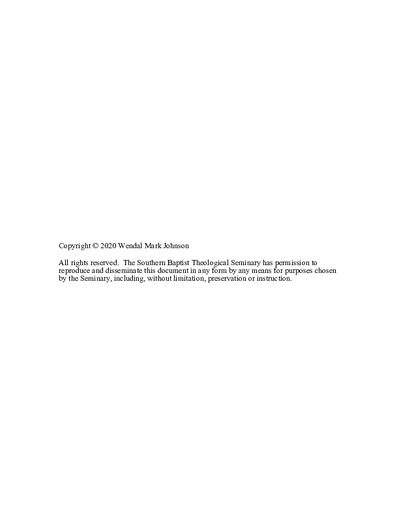Reaching the Secular City: A Practical Model for Brazilian Urban Missionaries Through the Lens of Lesslie Newbigin
Description
Ph.D., The Southern Baptist Theological Seminary, 2020
Abstract
ABSTRACT
REACHING THE SECULAR CITY: A PRACTICAL MODEL FOR BRAZILIAN URBAN MISSIONARIES THROUGH
THE LENS OF LESSLIE NEWBIGIN
Wendal Mark Johnson, PhD
The Southern Baptist Theological Seminary, 2020
Chair: Dr. George H. Martin
This dissertation examines an urban missionary training model to be used by missionary sending agencies in Brazil. Special attention is given to Lesslie Newbigin’s understanding of the secular city and how Christian Urban missionaries might most effectively engage it. Chapter 1 examines the definitions used in the dissertation with a focus on the importance of mentoring programs within present broader missiological trends. Chapter 2 examines the biblical foundations for urban missions, placing an urban missions training program within Scripture’s broader teaching of God’s purposes and plans for the city.
Chapter 3 introduces Lesslie Newbigin and gives an overview of his essential thoughts concerning missional analysis of Western culture, the missional nature of the church, and the Gospel as public truth. Chapter 4 examines the foundational concepts upon which Newbigin’s missiology is based and shows how Newbigin understands, develops, and applies these key concepts. An extensive investigation of the three essential missiological concepts that inform Newbigin’s approach to engaging the secular city is covered in Chapter 5.
Chapter 6 outlines lessons to be learned by urban missionaries to the world’s secular cities. It includes proposals for application based on Newbigin’s understanding of how the secular city is to be most effectively engaged. The results of an urban mission survey developed especially for urban missionaries serving in Brazil can be found in Chapter 7. This survey attempts to determine those factors that make for longevity in the Brazilian urban context and patterns of urban life that lead to high-levels of stress. Chapter 8 provides a profile of an urban missionary.
Chapter 9 presents the actual training structure being proposed. Focus is given to the program’s mission, objectives, and goals. Those who serve as the primary implementers of the urban mission training program, the coaches, are described in Chapter 10. In addition, a section is devoted to the training of these coaches. Chapter 11 concludes describing the assessment tools used to evaluate the urban missionaries trained according to the model.

